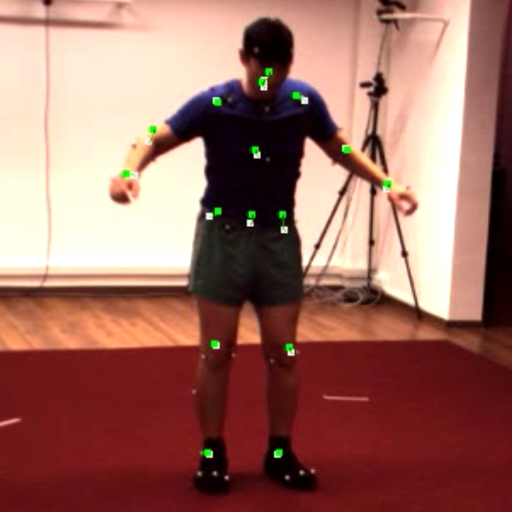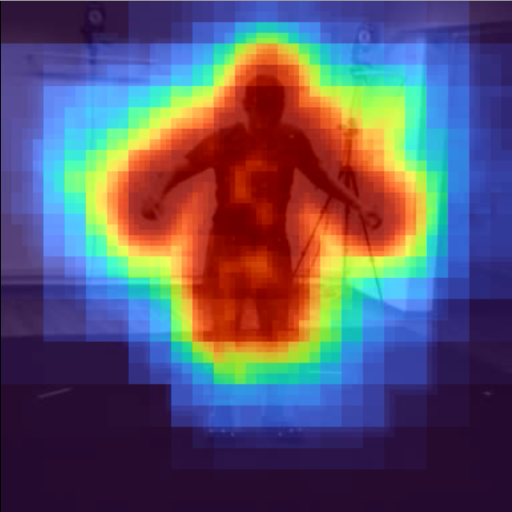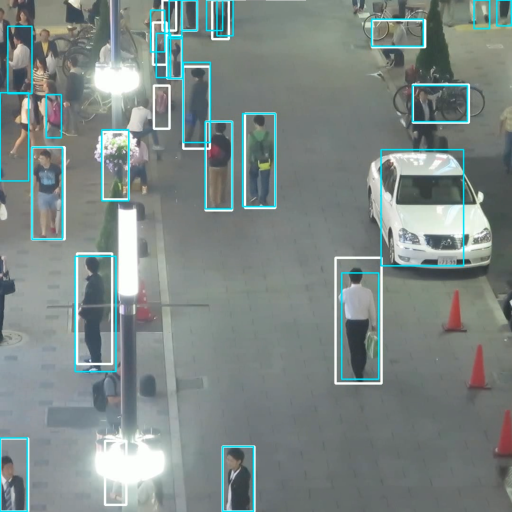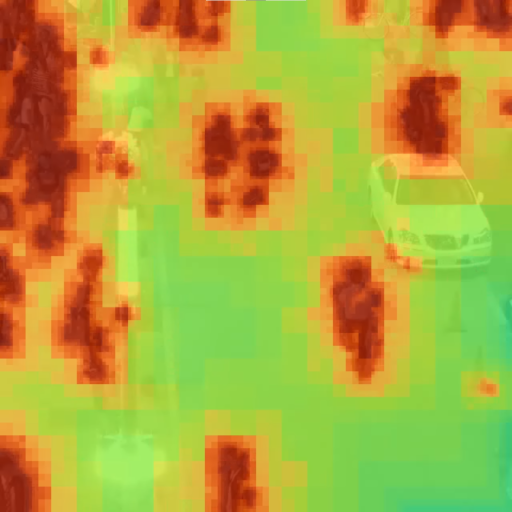We moved our repository to facebookresearch/DeltaCNN. For issues and latest updates, please visit facebookresearch/DeltaCNN.
DeltaCNN caches intermediate feature maps from previous frames to accelerate inference of new frames by only processing updated pixels. DeltaCNN can be used as a drop-in replacement for most layers of a CNN by simply replacing the PyTorch layers with the DeltaCNN equivalent. Model weights and inference logic can be reused without the need for retraining. All layers are implemented in CUDA, other devices are currently not supported.
A preprint of the paper is available on Arxiv.
Find more information about the project on the Project Website
 |
 |
 |
 |
|---|---|---|---|
| Prediction | Updates | Prediction | Updates |
DeltaCNN depends on:
- Python / Anaconda
- C++ compiler
- Windows: Visual Studio (msvc) with "Desktop development for C++"
- Linux: gcc/g++
- CUDA Toolkit 11.3
- PyTorch v1.10.2
(pip installation command:
pip3 install torch==1.10.2+cu113 torchvision==0.11.3+cu113 torchaudio===0.10.2+cu113 -f https://download.pytorch.org/whl/cu113/torch_stable.html) (anaconda installation command:conda install pytorch torchvision torchaudio cudatoolkit=11.3 -c pytorch)
Please install these packages before installing DeltaCNN.
- Navigate to DeltaCNN root directory
- Run
python setup.py install --user(This can take a few minutes)
example/mobilenetv2_webcam_example.py contains a simple example that showcase all steps needed for replacing PyTorch's CNN layers by DeltaCNN.
In this example, all steps required to port a network are highlighted with # added and # replaced by.
In the main file, we load the original CNN, and the DeltaCNN variant, and run both on webcam video input.
Play around with the DCThreshold.t_default to see how the performance and accuracy change with different values.
For the sake of simplicity, we avoided steps like fusing batch normalization layers together with convolutional layers or tuning thresholds for each layer individually.
Using DeltaCNN in your CNN project should in most cases be as easy as replacing all layers in the CNN with the DeltaCNN equivalent and adding a dense-to-sparse (DCSparsify()) layer at the beginning and a sparse-to-dense (DCDensify()) layer at the end. However, some things need to be considered when replacing the layers.
Nonlinear layers need unique instances for every location they are used in the model as they cache input/output feature maps at the current stage. To be safe, create a unique instance for every use of a layer in the model. For example, this toy model can be converted as follows.
####### PyTorch
from torch import nn
class CNN(nn.Module):
def __init__(self):
super(CNN, self).__init__()
self.conv1 = nn.Conv2d(...)
self.conv2 = nn.Conv2d(...)
self.conv3 = nn.Conv2d(...)
self.relu = nn.ReLU()
def forward(self, x):
x = self.relu(self.conv1(x))
x = self.relu(self.conv2(x))
return self.relu(self.conv3(x))####### DeltaCNN
import deltacnn
class CNN(deltacnn.DCModule):
def __init__(self):
super(CNN, self).__init__()
self.sparsify = deltacnn.DCSparsify()
self.conv1 = deltacnn.DCConv2d(...)
self.conv2 = deltacnn.DCConv2d(...)
self.conv3 = deltacnn.DCConv2d(...)
self.relu1 = deltacnn.DCActivation(activation="relu")
self.relu2 = deltacnn.DCActivation(activation="relu")
self.relu3 = deltacnn.DCActivation(activation="relu")
self.densify = deltacnn.DCDensify()
def forward(self, x):
x = self.sparsify(x)
x = self.relu1(self.conv1(x))
x = self.relu2(self.conv2(x))
return self.densify(self.relu3(self.conv3(x)))or simply:
####### DeltaCNN simplified
import deltacnn
class CNN(deltacnn.DCModule):
def __init__(self):
super(CNN, self).__init__()
self.sparsify = deltacnn.DCSparsify()
self.conv1 = deltacnn.DCConv2d(..., activation="relu")
self.conv2 = deltacnn.DCConv2d(..., activation="relu")
self.conv3 = deltacnn.DCConv2d(..., activation="relu", dense_out=True)
def forward(self, x):
x = self.sparsify(x)
x = self.conv1(x)
x = self.conv2(x)
return self.conv3(x)If you want to add layers not included in DeltaCNN or apply operations on the feature maps directly, be aware of the feature maps used in DeltaCNN. DeltaCNN propagates only Delta updates between the layers. The output of a DeltaCNN layer consists of a Delta tensor and an update mask. Be careful when directly accessing these values, as skipped pixels are not initialized and contain random values.
If you apply custom operations onto the feature maps, the safest way is to add a DCDensify() layer, apply your operation and then convert the features back to Delta features using DCSparsify(). For example:
####### PyTorch
from torch import nn
class Normalize(nn.Module):
def forward(self, x):
return x / x.max()####### DeltaCNN
from deltacnn import DCDensify, DCSparsify, DCModule
class Normalize(DCModule):
def __init__(self):
super(Normalize, self).__init__()
self.densify = DCDensify()
self.sparsify = DCSparsify()
def forward(self, x):
x = self.densify(x)
x = x / x.max()
return self.sparsify(x)DeltaCNN kernels only support torch.channels_last memory format. Furthermore, it expects a specific memory layout for the weights used in convolutional layers. Thus, after loading the weights from disk, process the filters before the first call. And be sure to convert the network input to channels last memory format.
class MyDCModel(DCModule):
...
device = "cuda:0"
model = MyDCModel(...)
load_weights(model, weights_path) # weights are stored in PyTorch standard format
model.to(device, memory_format=torch.channels_last) # set the network in channels last mode
model.process_filters() # convert filters into DeltaCNN format
for frame in video:
frame = frame.to(device).contiguous(memory_format=torch.channels_last)
out = model(frame)The easiest way to try DeltaCNN is to use a set a global threshold the DCThreshold.t_default variable before instantiating the model. Good starting points are thresholds in the range between 0.05 to 0.3, but this can vary strongly depending on the network and the noise of the video. If video noise is an issue, specify a larger threshold for the DCSparsify layer using the delta_threshold parameter and compensate if using update mask dilation.
For example: DCSparsify(delta_threshold=0.3, dilation=15).
Thresholds can also be loaded from json files containing the threshold index as key.
Set the path to the thresholds using DCThreshold.path = <path> and load the thresholds after predicting the first frame.
For example:
for frame_idx, frame in enumerate(video):
frame = frame.to(device).contiguous(memory_format=torch.channels_last)
out = self.model(frame)
if frame_idx == 0:
DCThreshold.path = threshold_path
DCThreshold.load_thresholds() On first call, all buffers are allocated in the size of the current input, the layers and logging layers are initialized and all truncation layers register their thresholds in the DCThreshold class. Optimizing the thresholds in a front-to-back manner can be done by iterating over all items stored in the ordered dictionary DCThreshold.t.
For example:
sequence = load_video()
DCThreshold.t_default = 0.0
model = init_model()
ref_loss = calc_loss(model, sequence)
max_per_layer_loss_increase = 1.001 # some random number
step_size = 2 # some random number
for key in DCThreshold.t.keys():
start_loss = calc_loss(model, sequence)
DCThreshold.t[key] = 0.001 # some random number
while calc_loss(model, sequence) < start_loss * max_per_layer_loss_increase:
DCThreshold.t[key] *= step_size
DCThreshold.t[key] /= step_size # since loss with prev threshold was already too large, go back a stepFor better ways to tune the thresholds, please read the respective section in the DeltaCNN paper.
DeltaCNN focuses on end-to-end sparse inference and therefore comes with common CNN layers besides convolutions. Yet, being a small research project, it does not provide all layers you might need or even support the provided layers in all possible configurations. If you want to use a layer that is not included in DeltaCNN, please open an issue. If you have some experience with CUDA, you can add new layers to DeltaCNN yourself - please consider creating a pull request to make DeltaCNN even better.
As a rough overview, DeltaCNN features the following layers:
DCSparsify/DCDensify: convert dense features to sparse delta features + update mask and backDCConv2d: Kernel sizes of 1x1, 3x3 and 5x5. All convolutions support striding of 1x1 and 2x2 as well as dilation of any factor and depthwise convolutions. Additionally, kernel size of 7x7 with a stride of 2x2 is also implemented for ResNet. All kernels can be used in float16 and float32 mode. However, as DeltaCNN does not support Tensor Cores (which cuDNN automatically uses in 16 bit mode), performance comparisons against cuDNN should be done in 32 bit mode for apples to apples comparisons.DCActivation:ReLU,ReLU6,LeakyReLU,SigmoidandSwish.DCMaxPooling,DCAdaptiveAveragePooling: Average and maximum are supported for different kernel sizes.DCUpsamplingNearest2d: By factors of 2, 4, 8 or 16.DCBatchNorm2d: BatchNorm parameters are converted into scale and offset on initialization.DCAdd: Adding two tensors (e.g. skip connection)DCConcatenate: Concatenating two tensors along channel dimension (e.g. skip connection)
-
As a starting point, we would suggest to use a small global threshold, or even 0 and to iteratively increase the threshold on the input until the accuracy decreases. Try to use a update mask dilation on the first layer together with high thresholds to compensate noise. Afterwards, try increasing the global threshold to the maximum that does not significantly reduce accuracy. Use this threshold as baseline when fine tuning individual truncation thresholds.
-
Fusing batch normalization layers together with convolutional layers can have a large impact on performance.
-
Switch between DeltaCNN and cuDNN inference mode without changing the layers by setting
DCConv2d.backendtoDCBackend.deltacnnorDCBackend.cudnn.
@article{parger2022deltacnn,
title = {DeltaCNN: End-to-End CNN Inference of Sparse Frame Differences in Videos},
author = {Mathias Parger, Chengcheng Tang, Christopher D. Twigg, Cem Keskin, Robert Wang, Markus Steinberger},
journal = {CVPR 2022},
year = {2022},
month = jun
}
DeltaCNN is released under the CC BY-NC 4.0 license.